|
Thursday, Feb. 7
1 p.m.
Physics and Detector Seminar - West Wing, WH-10NW
Speaker: T. Rizzo, Stanford Linear Accelerator Center
Title: SUSY at the ILC with the SiD Detector
2:30 p.m.
Theoretical Physics Seminar - Curia II
Speaker: T. Becher, Fermilab
Title: Precision Determination of αs from Thrust Distributions at LEP
3 p.m.
Computing Division Seminar - FCC1
Speaker: N. Desai, Argonne National Laboratory
Title: Bcfg2: Overview
3:30 p.m.
DIRECTOR'S COFFEE BREAK - 2nd Flr X-Over
4 p.m.
Accelerator Physics and Technology Seminar - One West
Speaker: E. Barzi, Fermilab
Title: Superconducting Strand and Cable R&D at FNAL
Friday, Feb. 8
3:30 p.m.
DIRECTOR'S COFFEE BREAK - 2nd Flr X-Over
4 p.m.
Joint Experimental-Theoretical Physics Seminar - One West
Speaker: S. Dube, Rutgers University
Title: Search for Supersymmetry at CDF Using Trileptons
Click here for NALCAL,
a weekly calendar with links to additional information.
|
Thursday, Feb. 7
- Minnesota wild rice w/chicken
- Tuna melt on nine grain
- BBQ ribs
- Chicken casserole
- Vegetarian salad wrap
- Assorted slice pizza
- Mandarin chicken
Wilson Hall Cafe menu |
|
Thursday, Feb. 7
Dinner
- Closed
Wednesday, Feb. 13
Lunch
- Sautéed salmon fillet w/watercress sauce
- Vegetable medley
- Apricot tart
Chez Leon menu
Call x4598 to make your reservation. |
|
|
Fermilab discusses
future with P5 panel
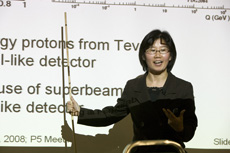
Fermilab Deputy Director Young-Kee Kim presents during the P5 meeting Jan. 31.
Physics leaders from across the globe met with members of the Particle Physics Project Prioritization Panel last week at Fermilab to discuss a vigorous physics plan for the nation.
"U.S. HEP needs a robust, viable, strategic plan that recognizes the nature of international commitments and ensures vitality and infrastructure for the field for the next 10 years," said Dennis Kovar, acting associate director for High Energy Physics at DOE's Office of Science, at a Town Hall meeting Friday afternoon. He called for a world-class, productive and adaptable program.
Fermilab speakers highlighted several of the laboratory's current and potential experiments that would ensure a vital future for the field.
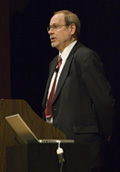 |
| Dennis Kovar, acting associate director for High Energy Physics at DOE's Office of Science, addressed P5 members and Fermilab scientists and staff at a Town Hall meeting Friday afternoon. |
Experiments that would give the U.S. flexible research options include NOvA, Project X and the ILC, along with an extended Tevatron run.
"With a plan, you build dreams, but we have to have legs to stand on, legs on which to build a platform for greater things," said Fermilab Director Pier Oddone.
Oddone described science at Fermilab, including the laboratory's strong neutrino program and recent Tevatron milestones. He called for a program that would make Fermilab a destination for university physicists.
DOE and NSF have charged P5 to develop recommendations to HEPAP. P5 members will complete their recommendations in April and present them in May, in time to incorporate into the planning process for the FY2010 budget
-- Rhianna Wisniewski
|
IceCube construction reaches halfway point
From Interactions.org,
Feb. 6, 2008
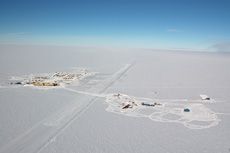
An overview of the South Pole with the South Pole Station to the left of the runway and IceCube, a neutrino experiment, to the right. Image courtesy of Forest Banks.
The IceCube team exceeded their 2007-2008 seasonal stretch goal of 18 detector strings, four more than the project baseline plan. The 18 down-hole cables mark the halfway point in the construction of the neutrino telescope that will detect neutrinos with energies exceeding TeV. IceCube now consists of 40 strings, each instrumented with 60 digital optical modules (DOMs). The IceCube drilling and deployment teams were able to drill 2500 km deep holes at the South Pole and deploy strings at the rate of about one every 50 hours, creating a detector that now has a volume of one half a cubic kilometer.
Collaboration spokesperson, Tom Gaisser, says, "I am deeply impressed with the incredible job done by the skilled drilling and deployment team. The outstanding support from Raytheon Polar Services Company was essential for our success this season. It is a very exciting time for the IceCube Collaboration!"
Scientists are now evaluating each DOM to determine that it survived the deployment and "freeze-in" process. This testing and calibration effort continues after the last members of the IceCube construction team leave the South Pole on February 15th. The IceCube winter team then takes over the job of incorporating the new DOMs into the data acquisition system. So far 99 % of the deployed DOMs that have been powered on are working. There are now 2400 DOMs in the ice at the South Pole. IceCube will reach a km2-year exposure within two years-a long anticipated milestone of neutrino astronomy.
Read more
|
Fermilab layoffs set for June
From Beacon News,
Feb. 6, 2008
Employees at Fermilab got a dose of good news this week, as President Bush's funding request for 2009 would, if approved, alleviate their budget woes.
But it's not in time to prevent the previously announced layoffs at the lab, officials said Tuesday.
Earlier this week, the Bush administration released its proposed 2009 budget, which includes a request for $397 million for Fermilab, a Department of Energy facility. That's an increase over the president's requested 2008 budget amount of $372 million, but that figure was chopped down to $320 million when Congress passed its appropriations bill in late December.
That shortfall -- down even from the $342 million the lab received in 2007 -- effectively halted work on several high-profile research projects, including the proposed International Linear Collider and the NoVA project, the next phase of the lab's neutrino experiments. Officials also instituted rolling furloughs for all employees, and warned that layoffs could be on the horizon.
In a letter to employees Tuesday, Fermilab Director Pier Oddone confirmed those layoffs. An estimated 200 employees will be let go, roughly 10 percent of the lab's work force.
Spokesman Judy Jackson said those layoffs would likely not take effect before June, and the goal is to keep the Tevatron, the lab's massive particle collider, up and running.
Read more
|
|
|
The beauty of asymmetry

These figures show the variable used to discriminate between top-pair production and background processes. The left figure shows events where the top quark is more forward with respect to the proton beam, and the right figure shows events where the anti-top quark is more forward.
Symmetry often defines aesthetic beauty or intrinsic quality. The harmony associated with symmetric designs shows up in many aspects of life, including art such as Leonardo da Vinci's "Vitruvian Man" and the alignment of the wheels on your car. The physics of elementary particles also has deep roots in symmetry, with fundamental symmetries in nature giving rise to the theories we use to describe the universe. DZero researchers have set out to defy this idea by seeking asymmetry in top quark production. But rather than fostering dissonance, their efforts deepen the beauty of the top quark and shed new light on physics at the Tevatron.
The Tevatron remains the only place in the world to directly study top quarks. Tevatron collisions produce top quark/antiquark pairs via the strong force, which is indifferent to the charge of the interacting particles. Simple theoretical calculations suggest the Tevatron's particle detectors should create symmetrical distributions of both tops and antitops. However, more detailed calculations suggest that these oppositely-charged particles should have a slight preference as to how they emerge from the collisions: Top quarks will prefer to go in the direction of the proton beam ("forward") whereas antitop quarks will preferentially go in the opposite direction ("backward"). The origins of this charge symmetry are subtle, but researchers should observe the resulting experimental signature at a predicted order of 5 percent. By measuring this asymmetry, physicists can compare to theoretical predictions and probe for potentially undiscovered new physics.
Physicists at the DZero experiment are publishing the first measurement of forward-backward charge-asymmetry in top quark pair production. Their result, submitted to Physical Review Letters, takes into account 0.9 inverse femtobarns of data and finds asymmetries consistent with detailed theoretical predictions. Using this result, DZero researchers are able to go one step further and constrain models where a heavy, neutral vector boson produces top quark pairs instead of production by the standard strong interaction. The beauty of this measurement lies not only in the result, but also in the technique that allowed analyzers to minimize dependencies on the precise model for generating the charge asymmetry. With more than twice the data waiting for analysis, the precision of this measurement will put even more pressure on models for new physics. Regardless of the outcome, DZero physicists have proven that beauty need not lie solely in symmetry.
Read more
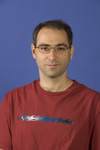 |
Amnon Harel of University of Rochester made primary contributions to this analysis. |
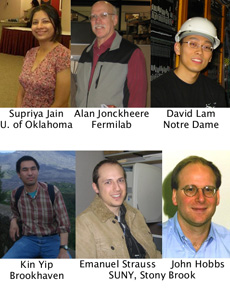
DZero's Reconstruction and Physics Certification group rapidly assesses the quality of the data recorded by the detector. Its efforts enable fast feedback to the detector and algorithm groups, ultimately ensuring timely and robust physics results ,such as the one shown here.
Result of the Week Archive
|
|
Have a safe day!
Register for S/CI training
Technical personnel and managers can sign up for suspect/counterfeit items identification training, scheduled to take place Feb. 11-14 at Fermilab. This training is required for construction supervisors and task managers. Three courses are offered: course 1, "Suspect/Counterfeit Items Identification", a two-hour, hands-on experience; and course 2, "Suspect/Counterfeit Items DOE Program", a 1.5-hour overview of DOE's S/CI program; and course 3 "Suspect/Counterfeit Items Train the Trainer", a three-hour, Q&A session intended for Fermilab individuals with responsibility to provide S/CI training for personnel within their division or section. Courses must be taken in order. Register at the ES&H Web site or contact Joel Kofron, x8444
Employee Black Hawk tickets
Fermilab employees can take advantage of discounted Black Hawk ticket for home games at the United Center Feb. 20, March 5 and March 9. Employees can save up to $22.50 on tickets. Order forms can be found in the Recreation Office, WH15W or on the Recreation homepage.
ESL class in Users Center
A beginning English as a Second Language course will meet from 10-11:30 a.m. every Wednesday from Jan. 30-May 14 in the Users' Center. The class will cover topics including daily conversation, shopping, transportation, travel, food, grocery, restaurant ordering and doctor visits. E-mail or call Kim Habig, x4240, for more information. New students may join anytime.
Additional Activities |
|